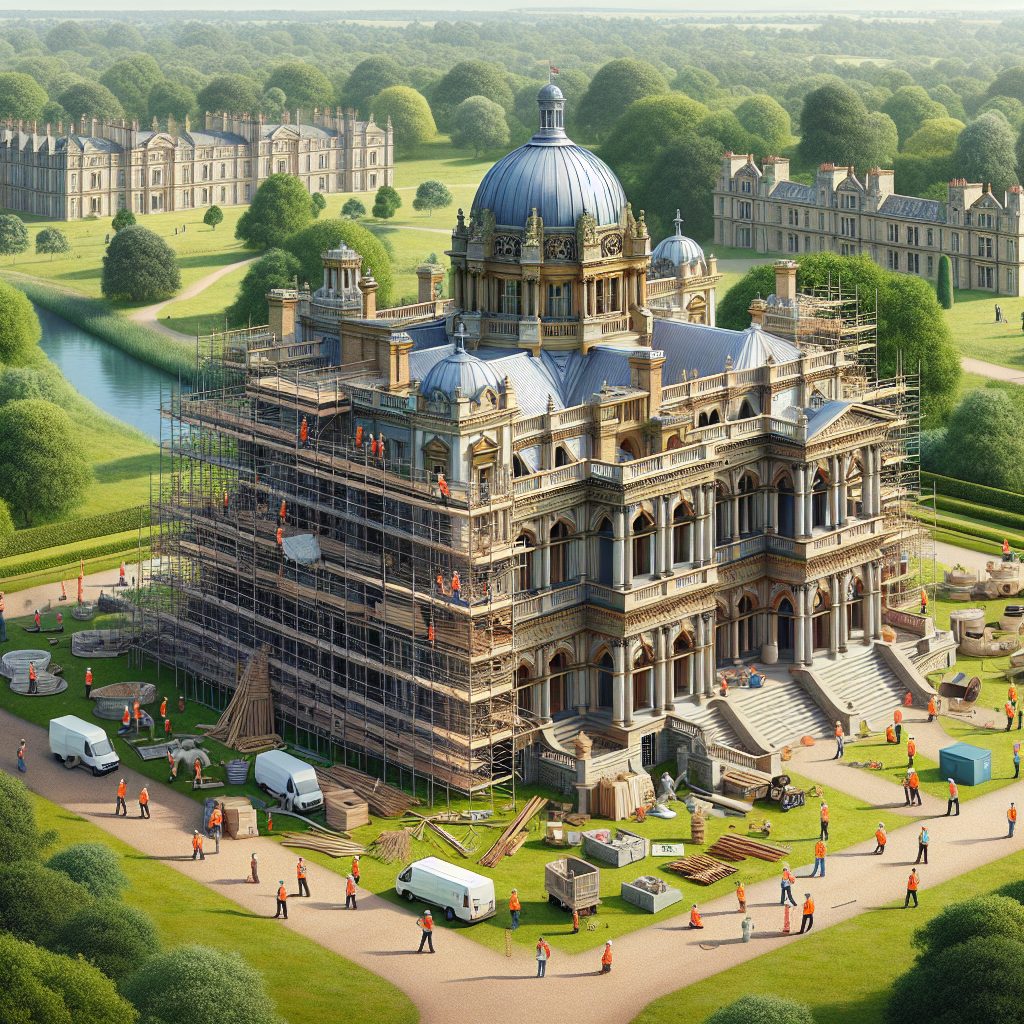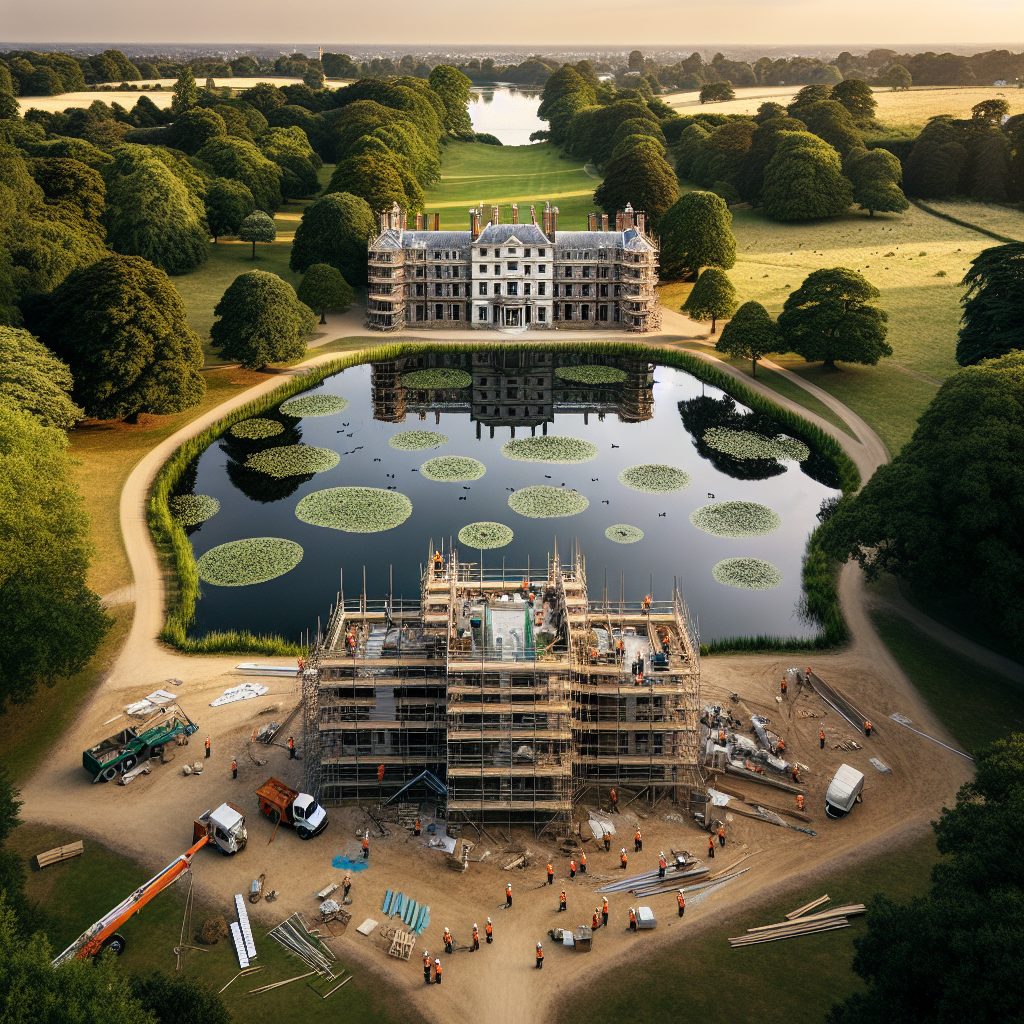Exploring the Architectural Wonders of Alexandra Palace: A Renovation Journey
Alexandra Palace, fondly known as the ‘People’s Palace,’ is a remarkable architectural marvel nestled in the heart of North London. This iconic structure, set within the verdant expanse of Alexandra Park, has been a beacon of culture and entertainment since its inception in 1873. However, the passage of time and the ravages of two fires have necessitated a series of renovations to preserve its historic grandeur. This article delves into the architectural wonders of Alexandra Palace, focusing on the intricate process of its renovation.
The first phase of the renovation journey involved a meticulous assessment of the existing structure. The palace’s architectural style, a blend of Victorian and Italianate, required a careful evaluation to ensure that the renovations would not compromise its original aesthetic. The palace’s distinctive features, such as the Great Hall’s rose window, the theatre’s decorative ceiling, and the Palm Court’s glass roof, were all painstakingly documented. This process was crucial in providing a blueprint for the restoration work, ensuring that each element was faithfully recreated.
Following the assessment, the next step was the actual renovation work. This phase was marked by a delicate balance between modern construction techniques and traditional craftsmanship. For instance, the Great Hall’s rose window, a stunning example of Victorian stained glass artistry, was restored using traditional methods. Each piece of glass was individually removed, cleaned, and repaired or replaced as necessary. The result is a breathtakingly beautiful window that shines with renewed vibrancy, a testament to the skill and dedication of the restoration team.
In contrast, the renovation of the palace’s East Court required a more modern approach. The original glass roof, once a marvel of Victorian engineering, had deteriorated significantly over the years. The renovation team opted to replace it with a new, energy-efficient glass structure. This decision not only ensured the preservation of the court’s airy, light-filled ambiance but also improved its sustainability.
The theatre, a hidden gem within the palace, presented a unique challenge. Over the years, it had been used as a cinema, a chapel, and even a prop store, resulting in significant alterations to its original design. The renovation team embarked on a painstaking process of uncovering and restoring the theatre’s original features. The decorative ceiling, once hidden under layers of paint, was revealed in all its ornate glory. The stage, too, was restored to its original size, allowing the theatre to once again host performances.
The renovation of Alexandra Palace was not just about restoring its physical structure. It was also about preserving its rich history and cultural significance. To this end, the palace’s Victorian theatre and BBC studios were transformed into a museum, showcasing the palace’s role in the development of television and its history as a venue for music, sport, and entertainment.
In conclusion, the renovation of Alexandra Palace is a testament to the power of preservation. It is a journey that has breathed new life into an architectural wonder, ensuring that it continues to be a beacon of culture and entertainment for generations to come. The ‘People’s Palace,’ with its blend of Victorian and Italianate architecture, its rich history, and its vibrant cultural offerings, stands as a shining example of successful renovation, a testament to the skill, dedication, and vision of those who undertook this monumental task.
Revitalizing History: The Transformation of Alexandra Park’s Historic Homes

Alexandra Park, a historic gem nestled in the heart of North London, is renowned for its rich architectural heritage. The park, named after Alexandra of Denmark, is home to a plethora of Victorian-era houses that have stood the test of time. However, these historic homes have recently been the subject of a significant transformation, a house renovation project that aims to revitalize and preserve their historic charm while adapting them to the needs of modern living.
The renovation process is a delicate balancing act that requires a deep understanding of the architectural nuances of the Victorian era. The homes in Alexandra Park are characterized by their ornate detailing, high ceilings, and large windows, features that are emblematic of the period’s architectural style. The challenge lies in preserving these distinctive features while incorporating modern amenities and design elements.
The first step in the renovation process involves a thorough assessment of the property’s structural integrity. Given the age of these homes, it is not uncommon to encounter issues such as damp, timber decay, or even structural instability. These issues need to be addressed promptly to ensure the safety and longevity of the property. The use of modern technology, such as thermal imaging and 3D scanning, has proven invaluable in identifying and rectifying these problems.
Once the structural issues have been addressed, the focus shifts to the aesthetic aspects of the renovation. The goal is to retain the property’s historic charm while making it comfortable and functional for contemporary living. This involves a careful selection of materials and finishes that are in keeping with the property’s historic character. For instance, traditional lime plaster is often used instead of modern gypsum plaster to maintain the property’s breathability and prevent damp.
The renovation of historic homes in Alexandra Park also involves the careful restoration of original features. This includes intricate cornicing, ceiling roses, and original fireplaces, which are painstakingly restored to their former glory. Where original features are missing or beyond repair, replicas are created using traditional methods and materials to ensure they blend seamlessly with the rest of the property.
The incorporation of modern amenities is done in a way that respects the property’s historic character. For instance, modern kitchens and bathrooms are designed with a nod to the Victorian era, using traditional-style fixtures and fittings. Energy-efficient heating and insulation systems are installed to improve the property’s thermal performance, a crucial aspect of making these historic homes suitable for modern living.
The house renovation project in Alexandra Park is not just about preserving the past; it’s about ensuring these historic homes have a future. By sensitively updating these properties, they can continue to be enjoyed by generations to come. The project is a testament to the enduring appeal of Victorian architecture and a shining example of how the past and present can coexist harmoniously.
In conclusion, the transformation of Alexandra Park’s historic homes is a meticulous process that requires a deep understanding of the property’s architectural heritage. It involves a delicate balance of preservation and modernization, ensuring these homes retain their historic charm while meeting the demands of modern living. The result is a collection of homes that are not only a testament to the architectural prowess of the Victorian era but also a beacon of sustainable and sensitive renovation practices.
Innovative Renovation Ideas Inspired by Alexandra Palace
Alexandra Palace, a historic entertainment venue in London, is a beacon of architectural innovation and design. Its renovation in recent years has sparked a wave of inspiration for homeowners looking to revamp their own spaces. This article will explore some of the innovative renovation ideas inspired by Alexandra Palace, focusing on how these concepts can be applied to residential properties.
The first noteworthy aspect of Alexandra Palace’s renovation is its successful blend of old and new. The palace, originally built in 1873, has been carefully restored to preserve its historical charm while incorporating modern amenities and design elements. This approach can be mirrored in house renovations by maintaining original architectural features such as fireplaces, cornices, and hardwood floors, while updating other areas with contemporary fixtures and finishes. This fusion of old and new creates a unique aesthetic that is both timeless and trendy.
Another innovative idea drawn from Alexandra Palace’s renovation is the use of natural light. The palace’s iconic glass roof allows sunlight to flood the interior, creating a bright, airy atmosphere. Homeowners can replicate this effect by installing skylights or large windows, or by removing walls to create an open-plan living space. Not only does this make the home feel more spacious, but it also reduces the need for artificial lighting, making the property more energy-efficient.
The renovation of Alexandra Palace also demonstrates the power of versatile spaces. The palace is designed to accommodate a wide range of events, from concerts to exhibitions, thanks to its flexible layout and movable partitions. In a residential context, this concept can be applied by creating multi-purpose rooms that can easily be adapted to suit different needs. For example, a spare bedroom could double as a home office, or a dining room could be transformed into a playroom for children. This maximises the use of space and adds value to the property.
The use of sustainable materials is another key feature of Alexandra Palace’s renovation. The palace’s new energy centre, for instance, is built from timber sourced from sustainably managed forests. Homeowners can follow suit by choosing eco-friendly materials for their renovations, such as reclaimed wood, recycled glass, or low-VOC paints. This not only minimises the environmental impact of the renovation, but also contributes to a healthier indoor environment.
Lastly, the renovation of Alexandra Palace highlights the importance of landscaping in enhancing the overall appeal of a property. The palace is surrounded by Alexandra Park, a beautifully landscaped garden that complements the architecture and provides a tranquil setting for visitors. Similarly, homeowners can invest in professional landscaping to improve their property’s curb appeal and create an outdoor space that is both functional and aesthetically pleasing.
In conclusion, the renovation of Alexandra Palace offers a wealth of inspiration for homeowners looking to update their properties. By blending old and new, maximising natural light, creating versatile spaces, using sustainable materials, and investing in landscaping, homeowners can achieve a renovation that is not only stylish and functional, but also respectful of the environment and the property’s historical character.

